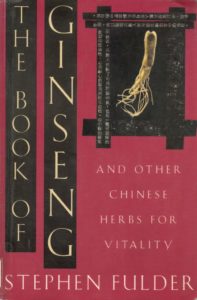
The Book of Ginseng and Other Chinese Herbs for Vitality. / Stephen Fulder, Healing Arts Press, 1993 (c1980).
The Book of Ginseng and Other Chinese Herbs for Vitality by Stephen Fulder, was first published in 1980. At the time, only believers in Oriental medical advice had experience with the substance as a cure-all for debility; for the general public, its use was mysterious and shrouded in controversy. Yet since then, we herbivores have all had a taste of ginseng, at least as a tea; which means that over the 30 intervening years this book has become more relevant than ever, a veritable bible of the root.
The book is composed of four parts: Part 1 is called Background; Part 2, Exposition; Part 3, Implications; and Part 4, Conclusions. After Part 4, there’s an Appendix that provides practical advice about purchasing, storing, and cooking the root, entitled “Ginseng and You”. Notes and the Index make up the end of the text.
You can tell from the chapter titles this is no ordinary essay. Read “The Root with Two Faces” to understand the dilemmas which wholesale adoption of an Eastern traditional medicine brings to a Western culture. In “The Chinese Alternative”, also in Part 1 (or Background), is an account of Chinese medicine from earliest times to the twentieth century when ancient Chinese and a form of Western medicine are used together. Part 3 offers insight into what happens when ginseng is substituted for the use of mainstream drugs. In Part 4, the Reader sees how “pharmacology of the future” will indeed change to offer a range of “restorative and adjustive” substances.
Ginseng is the common name which most often refers to the plant root taken for health. Originally named Panax ginseng by botanist C.A. Meyer, ginseng has been identified as a magic potion that relieves any physical or mental debility or frailty and halts the aging process.
Though there are a number of roots commonly referred to as ginseng, high quality roots are the best supplemental nutrition humans can ingest; hence the botanical name Panax, which is close to our word panacea. However, the knowledge that such plants exist encourages unrealistic expectations, fosters outrageous and unsubstantiated claims. The interpretation of such mysterious substances in our culture tended to invest ginseng with powers out of proportion to its capacity.
Fulder justifies our need for “strong revitalizing agents” found in the harmony remedies, namely the ginsengs, the premiere herbal or biologically available remedy for aging. His table of 24 harmony remedies from plants and three from animals shows familiar herbal sources as well as ginsengs: licorice, ginger, poria, jujube, peony, and schizandra, sage, lyceum, lotus and Solomon’s seal. Each of these herbal sources has a reputation in indigenous medicine for tonic or harmonizing effects, and some are used alone. But the use of ginsengs alone is uncommon, as they’re most often prescribed in “vitality concoctions”, p. 112, indicating that formulations are the best way to absorb the benefits of the roots. Often these formulations carry a ginseng supported by other herbs.
The evidence found in research shows that ginsengs contain substances called ginsenosides or ginseng-steroids, having either arousing or sedative qualities to offer humans. Ginsenosides are particularly suited to human adrenal glands in the balancing act between stimulus and stamina. In fact, these substances support our hormonal response to stress.
It’s no surprise to see that Fulder coins a term to describe the full range of this relationship and the benefits that can be had with using the ginsengs: he calls them somatensics, a word that means body-stretchers, those substances that exercise the limits of human capacity, resulting in increased power to resist the effects of stress.
Follow


